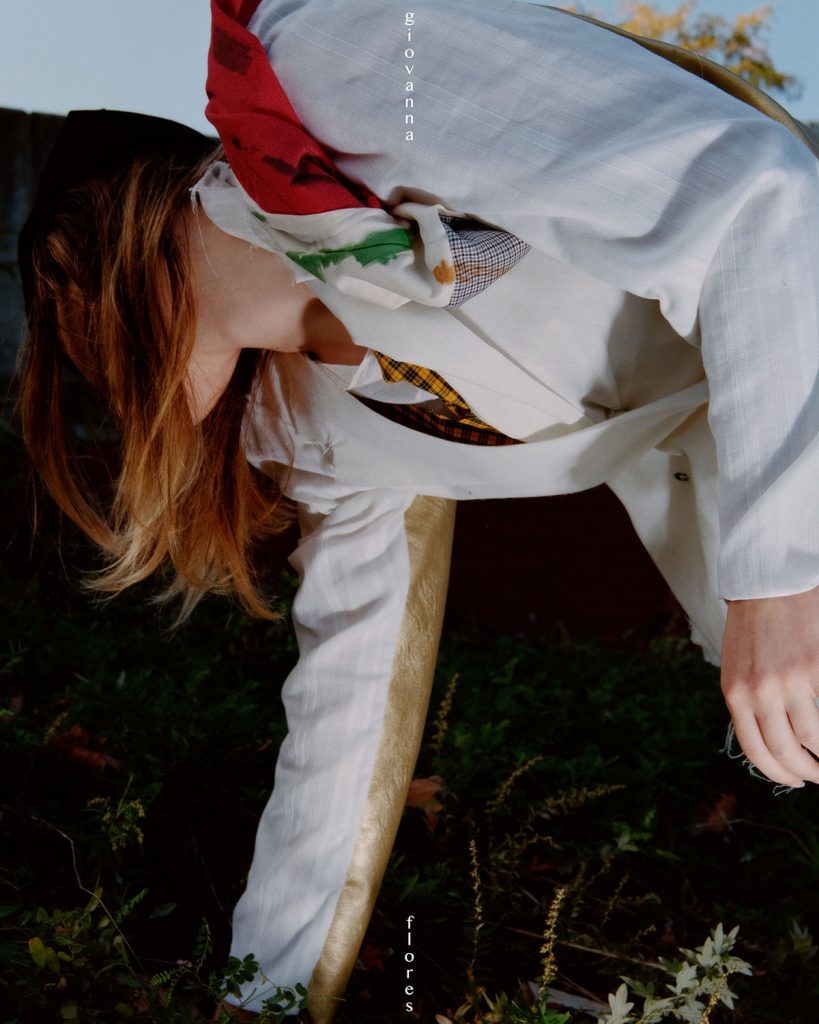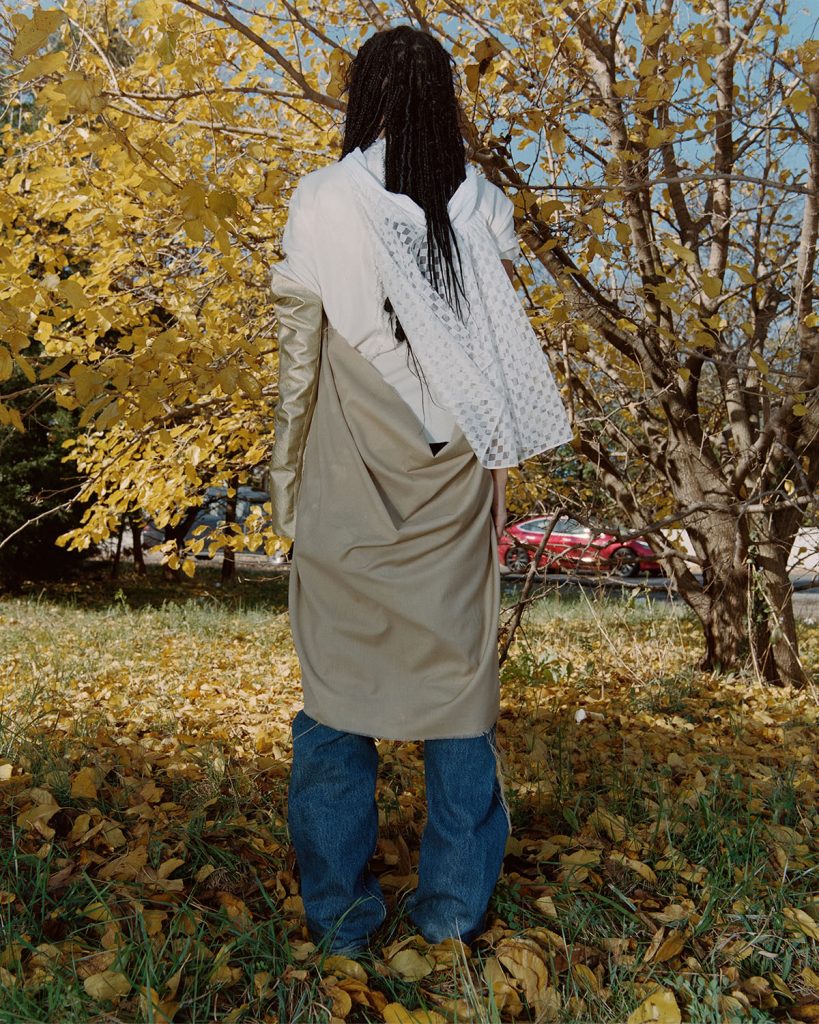Looking at photographs of figures occupying an unmarked natural green space. There are reminders of industrial life behind them: a concrete traffic barrier scrapes through the background. We can see a shiny red car, a glimpse of the tarmac. It could be almost anywhere. Faces are either obscured or completely turned away from the camera. The people appear to be playing or foraging, activities that are innocent enough. There is, however, something deeply unnerving about these images. Nothing is clear. It is placeless, faceless and the clothing—where we should be placing our focus—is obscured. They arouse the feeling of an anxiety dream.

These photos make up the Collection 8 campaign for Giovanna Flores. Being her first body of work released after an unofficial hiatus of two years, it is quite different from previous outputs. At first glance what is most apparent is that the New York-based designer has decided to use models.
Until now Flores has modelled in her own campaigns. The process of shooting the person who has made the clothes is both an exercise in taking any specific identity out of the work and, on a more personal note, to document the time in her life when these pieces were produced. “There’s a blankness there I think is nice”, Flores explains over Zoom from an undisclosed location in Florida, where she’s been shacked up with her boyfriend for the last few months. But now, in this strange green space in Brooklyn, Flores seems to be recording something more universal: unease centred around the endless possibilities of the unknown.
Flores’ work is emotional both for herself and the wearer. In particular, through its construction and materiality, it stirs memories. Draped and cut directly on a mannequin and fitted to her own body. To wear the clothing, one feels it already has the physicality of a person imbued in its shape. Textiles are selected for their evocative qualities: old scraps marked with stains and signs of repair are matched with new, crisp fabrics. “I like the idea of the clothes I make to remind people of past things, or be able to represent objects they see every day,” Flores explains her choice in material.
For previous collections, second-hand graphic t-shirts have been gathered at the front so that the images are obscured, but they are still there, partially recognisable. Scraps from fabric bins at her favourite shops in New York are hoarded for years until she decides on the right pieces to develop from them. Even orders for clients are reconstructed from memory—it is entirely essential to her working method.

To make Collection 8, Flores was granted something she hadn’t had in a while: lots of time. Since 2019 she had been apartment-less, travelling between New York, Los Angeles and Europe for work. The constant movement meant that everything she was making began to feel amorphous. Different parts of collections were bleeding into each other, muddying any distinction. Realising that her lack of official output meant she’d accidentally been left out of the fashion system for a few years, when the pandemic hit she decided to take her time to work on a new collection, questioning her place in the industry.
**Collection 8 feels different from past collections in various ways. One notable element in the clothes themselves is that you’ve purposefully left some garments—a few sleeves and a trouser leg—‘unfinished’. Can you tell me a little about the thought behind this decision?
Giovanna Flores: Making the collection, I was having a constant conversation with myself about what the feeling of ‘finished’ is. I would look at this sleeve that I was so happy with but after sitting with it for a while I’d start questioning myself. I’d be like, ‘What should this go on?’ But why should I finish it? Maybe it is done and I’m forcing something on to this piece. You know, I could wear a black t-shirt and throw on this one crazy sleeve, and it makes it a thing. That’s something that I think has energy in it, which I don’t see very often.
For this collection, I really just let myself go with how I felt each day. Some pieces I did drape on a mannequin—it wasn’t all just piecey stuff. I do like to drape, and I do like to dress the body. It was just about seeing that separation for what it is.
**Thinking about the versatility of something like a sleeve, it mirrors the way in which you work. Often you will start with a scrap of fabric and consider the possibilities of that piece. Designing just one sleeve, it’s like you’re allowing other people to go on that journey.

GF: Yeah, I agree. I always work from fabric I’ve kept forever. For this, though, it felt a bit different. The scraps started to feel too new to me, so I tried painting on top of them and then patching some smaller pieces together to make bigger yards of fabric. I would make two yards of fabric and I felt like they were done. I was like, ‘Oh god, you can’t start liking yards of fabric now!’ because what is that? You can’t even call that anything—it’s not clothes! But it comes out in the collection. There are a few dresses that are squares with slits in them for the arms and neck, where it’s basically like you’re wearing this piece of fabric.
**Can you explain a bit about how the pace of working on this collection differs from previous ones?
GF: In the past I’ve tried to put out collections twice a year, working with the schedule. This time I just let it go on, and on, and on. I feel like I’ve been trying to figure out what it is I really want to make, and how to do it in a way that makes sense for me. I don’t think I ever really went along with the fashion calendar. I hate the question that’s like, ‘Is it art or is it fashion or something in between the two?’ I wanted to take a little bit of time to figure out what those lines are for me—I think I’m still figuring it out.
**The location for the campaign images feels appropriate for a time in which we’re interacting with the outside in these small green spaces, surrounded by city detritus. It feels unnerving, emotionally connected to feeling trapped in a small geographical location. Can you explain a bit about the significance of these spaces in relation to the collection?
GF: I met the photographer [Dan McMahon] when I was interning for Susan [Cianciolo]. That was when I was still in college and ever since then, if I’m in New York we’ve worked together. I can call him on the day and be like, ‘Are you free today?’ That day he just biked over.

We walked around and ended up finding these weird spaces in between freeways. They had these clothes and random knick knacks all over them. It was almost like people had been hanging out there—there was all this nail polish, and flip flops and stuff but other than that it was untouched, and super overgrown. It was nice having this stillness in between the constant movement of the freeway.
The space felt like how I felt while I was making the clothes. Very early in the lockdown I was like, ‘Okay, you finally have time to make work,’ but then everything happened with George Floyd and the protests. Then on top of that it was becoming an increasingly severe lockdown with a curfew, it all felt insane. So I stopped working on the collection, it just didn’t feel right. Months passed and I started again, and it began to feel like I was alone and enclosed in this quiet space with so much happening around me. It felt right to shoot in that sort of space too.
**Up until now you’ve shot the campaigns on yourself. Previously you’ve spoken about not wanting to shoot on models because you didn’t want to envision some kind of ideal person for your clothes. The faces of the model for this lookbook are obscured in the images. Was this intentional?
GF: I’m not totally averse to using models. I have used them before but I think there’s something powerful about taking the person out of it, leaving it open for anyone to step into. You can put whatever on to a ‘cool’ person and it’ll look ‘cool’ but if there’s blankness there then it’s something different. It can be more about the image or the feeling.
A big thing about me shooting the collection on myself is that I am taking the person out of the clothes. I make the clothes, and I’m wearing the clothes so it’s not really about me at all. But this time I wanted to be able to step back and look at the stuff on other people.

I was dying to see the clothes on bodies. I was in my apartment alone every day, not seeing any people. The one mirror in my apartment broke in early April, so I hadn’t seen the clothes on a body. I would take photos of myself, like, ‘Okay, this looks like this,’ but it just felt so stupid to go out and try to get a mirror during lockdown—like is this really what you’re taking the risk to do, buy a mirror? I already work with basically nothing, so to take a mirror away was really intense.
**Can you talk to me a little about the importance of memory in your work?
GF: I sometimes think of being nostalgic as a sweet thing, but it can be a bit like being stuck in time. Memory has always been a really important aspect of my work. I mean, clothes are on your body and they do everything you do. I feel like clothes are such a representation of where you are, or have been. It’s always been important for me to see life in my work, even when it’s not on a body.
Mending and stains are so nice to see in new pieces because it’s such a clear representation of the clothes being worn, which is what clothes are meant to be used for. I also really like the tension of putting dirt and stains, and mending right next to the most optical, white, starchy new shirt. I feel like that tension is always really important in my work.
**What is it you’re particularly drawn to within that tension?
GF: The optic white shirt is representative of buying and newness, and feeling shiny, which is very ‘fashion’. I think that’s just as important as the other stuff—the pieces that have been worn, which are quite romantic and soft. That’s why I like to make clothes, putting both of this stuff together and seeing what that brings to a piece.**
Giovanna Flores’s Collection 8 is available on request from the designer. More info can be found at giovannaflores.com.













